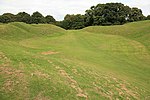A419 road
Infobox road instances in the United KingdomInfobox road maps tracking categoryRoads in EnglandTransport in GloucestershireTransport in Wiltshire ... and 1 more
Use British English from February 2013

The A419 road is a primary route between Chiseldon near Swindon at junction 15 of the M4 with the A346 road, and Whitminster in Gloucestershire, England near the M5 motorway. The A419 is managed and maintained by a private company, Road Management Group, on behalf of the UK Department for Transport.
Excerpt from the Wikipedia article A419 road (License: CC BY-SA 3.0, Authors, Images).A419 road
Stroud Road, Cotswold District
Geographical coordinates (GPS) Address Nearby Places Show on map
Geographical coordinates (GPS)
| Latitude | Longitude |
|---|---|
| N 51.71395 ° | E -2.00475 ° |
Address
Stroud Road
Stroud Road
GL7 6JT Cotswold District
England, United Kingdom
Open on Google Maps








